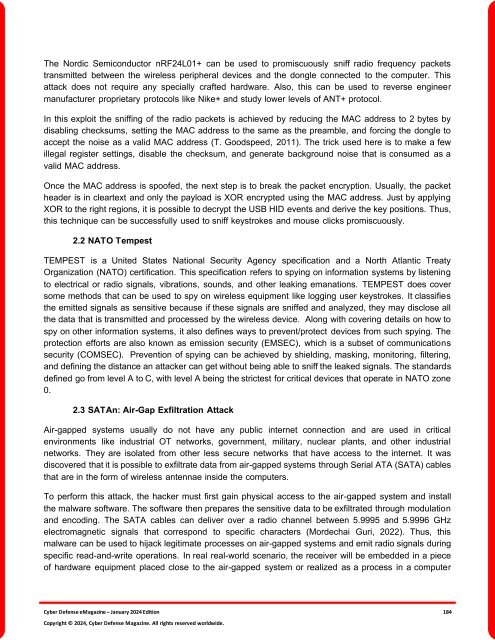The Cyber Defense eMagazine January Edition for 2024
Cyber Defense eMagazine January Edition for 2024 #CDM #CYBERDEFENSEMAG @CyberDefenseMag by @Miliefsky a world-renowned cyber security expert and the Publisher of Cyber Defense Magazine as part of the Cyber Defense Media Group as well as Yan Ross, Editor-in-Chief and many more writers, partners and supporters who make this an awesome publication! 201 page January Edition fully packed with some of our best content. Thank you all and to our readers! OSINT ROCKS! #CDM #CDMG #OSINT #CYBERSECURITY #INFOSEC #BEST #PRACTICES #TIPS #TECHNIQUES
Cyber Defense eMagazine January Edition for 2024 #CDM #CYBERDEFENSEMAG @CyberDefenseMag by @Miliefsky a world-renowned cyber security expert and the Publisher of Cyber Defense Magazine as part of the Cyber Defense Media Group as well as Yan Ross, Editor-in-Chief and many more writers, partners and supporters who make this an awesome publication! 201 page January Edition fully packed with some of our best content. Thank you all and to our readers! OSINT ROCKS! #CDM #CDMG #OSINT #CYBERSECURITY #INFOSEC #BEST #PRACTICES #TIPS #TECHNIQUES
You also want an ePaper? Increase the reach of your titles
YUMPU automatically turns print PDFs into web optimized ePapers that Google loves.
<strong>The</strong> Nordic Semiconductor nRF24L01+ can be used to promiscuously sniff radio frequency packets<br />
transmitted between the wireless peripheral devices and the dongle connected to the computer. This<br />
attack does not require any specially crafted hardware. Also, this can be used to reverse engineer<br />
manufacturer proprietary protocols like Nike+ and study lower levels of ANT+ protocol.<br />
In this exploit the sniffing of the radio packets is achieved by reducing the MAC address to 2 bytes by<br />
disabling checksums, setting the MAC address to the same as the preamble, and <strong>for</strong>cing the dongle to<br />
accept the noise as a valid MAC address (T. Goodspeed, 2011). <strong>The</strong> trick used here is to make a few<br />
illegal register settings, disable the checksum, and generate background noise that is consumed as a<br />
valid MAC address.<br />
Once the MAC address is spoofed, the next step is to break the packet encryption. Usually, the packet<br />
header is in cleartext and only the payload is XOR encrypted using the MAC address. Just by applying<br />
XOR to the right regions, it is possible to decrypt the USB HID events and derive the key positions. Thus,<br />
this technique can be successfully used to sniff keystrokes and mouse clicks promiscuously.<br />
2.2 NATO Tempest<br />
TEMPEST is a United States National Security Agency specification and a North Atlantic Treaty<br />
Organization (NATO) certification. This specification refers to spying on in<strong>for</strong>mation systems by listening<br />
to electrical or radio signals, vibrations, sounds, and other leaking emanations. TEMPEST does cover<br />
some methods that can be used to spy on wireless equipment like logging user keystrokes. It classifies<br />
the emitted signals as sensitive because if these signals are sniffed and analyzed, they may disclose all<br />
the data that is transmitted and processed by the wireless device. Along with covering details on how to<br />
spy on other in<strong>for</strong>mation systems, it also defines ways to prevent/protect devices from such spying. <strong>The</strong><br />
protection ef<strong>for</strong>ts are also known as emission security (EMSEC), which is a subset of communications<br />
security (COMSEC). Prevention of spying can be achieved by shielding, masking, monitoring, filtering,<br />
and defining the distance an attacker can get without being able to sniff the leaked signals. <strong>The</strong> standards<br />
defined go from level A to C, with level A being the strictest <strong>for</strong> critical devices that operate in NATO zone<br />
0.<br />
2.3 SATAn: Air-Gap Exfiltration Attack<br />
Air-gapped systems usually do not have any public internet connection and are used in critical<br />
environments like industrial OT networks, government, military, nuclear plants, and other industrial<br />
networks. <strong>The</strong>y are isolated from other less secure networks that have access to the internet. It was<br />
discovered that it is possible to exfiltrate data from air-gapped systems through Serial ATA (SATA) cables<br />
that are in the <strong>for</strong>m of wireless antennae inside the computers.<br />
To per<strong>for</strong>m this attack, the hacker must first gain physical access to the air-gapped system and install<br />
the malware software. <strong>The</strong> software then prepares the sensitive data to be exfiltrated through modulation<br />
and encoding. <strong>The</strong> SATA cables can deliver over a radio channel between 5.9995 and 5.9996 GHz<br />
electromagnetic signals that correspond to specific characters (Mordechai Guri, 2022). Thus, this<br />
malware can be used to hijack legitimate processes on air-gapped systems and emit radio signals during<br />
specific read-and-write operations. In real real-world scenario, the receiver will be embedded in a piece<br />
of hardware equipment placed close to the air-gapped system or realized as a process in a computer<br />
<strong>Cyber</strong> <strong>Defense</strong> <strong>eMagazine</strong> – <strong>January</strong> <strong>2024</strong> <strong>Edition</strong> 184<br />
Copyright © <strong>2024</strong>, <strong>Cyber</strong> <strong>Defense</strong> Magazine. All rights reserved worldwide.

















